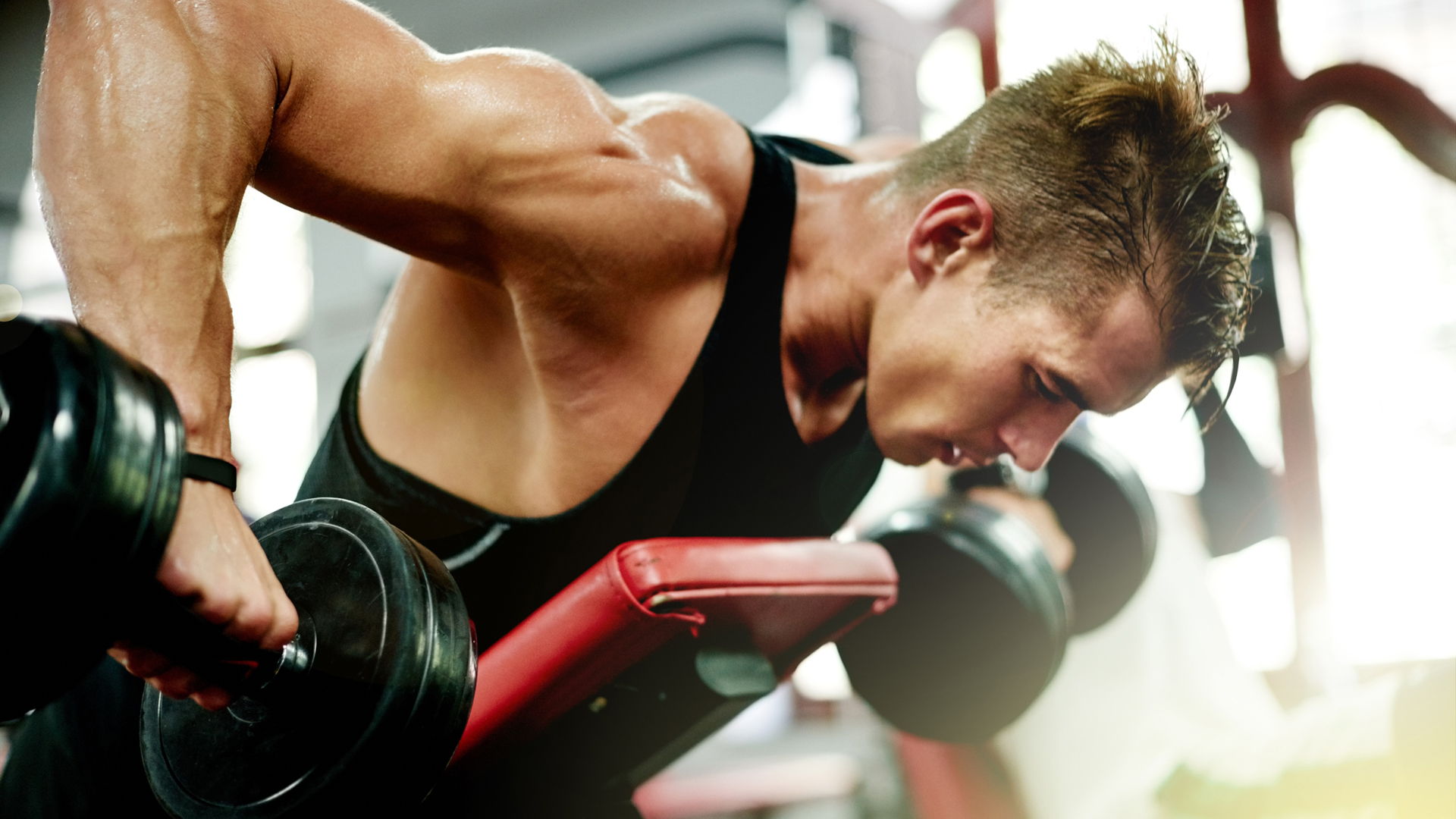

Ever wondered what's the secret of convincing people you have arms as big as Sylvester Stallone? It's having huge, boulder-sized, 3-dimensional shoulders. And you can too build huge delts with the best shoulder exercises for men using only dumbbells. Better still, you only need three exercises to achieve Peak Delts.
But we'll provide you with more than just the best shoulder exercises. Below you'll find all the information, from anatomy to diet, to help you build muscles the most efficient way possible.
The shoulder is the most mobile joint in the body and plays a role in every single upper body exercise that you do. These factors, combined with improper exercise selection and execution explain why they’re the subject of so many injuries. This means that people often skip them or find they can’t train them hard enough to pack on mass.
Don't be those people and start growing your delts today.
Shoulder anatomy
You need to understand the anatomy of your shoulders in order to build them to monolithic proportions. To develop perfect proportions, we’re basically going to concern ourselves with the following three muscle groups.
Anterior deltoids: Your anterior delts cover the front of your shoulder and are responsible for abduction; engage in any pushing or raising motion in front of the body and you’re hitting your anterior delts.
Medial Deltoids: Medial delts are the biggest shoulder muscles and are also responsible for abduction. Adding mass to these is what’s going to achieve that “capped” look that everyone craves.
Get all the latest news, reviews, deals and buying guides on gorgeous tech, home and active products from the T3 experts
Posterior Deltoids: Your posterior delts not only take care of external rotation and transverse abduction but are renowned for getting the least love of the three muscle groups that make up your shoulders. That’s a huge mistake because packing on muscle here will make your tricep look thicker and help to fill out those shirt sleeves.
Why grow your shoulders?
Broad shoulders and a narrow waist are the cornerstones of a classic bodybuilding physique. In lifting circles, your delts are a key component of what’s known as the “Top Shelf”, that area of muscle between your upper chest and neck. Absolutely nothing gives you that jacked appearance faster than packing mass across that Top Shelf.
Stronger shoulders also help in just about every exercise you can think of. Most people want to bench press heavy but they rarely press in the vertical plane. I guarantee that a few extra kilos added to your strict press will do wonders for your bench.
The following exercises and routines are going to get your shoulders growing or grow again if you're experiencing a plateau in your progression.
The equipment you need
You don’t build a Top Shelf with push-ups and bicep curls. You’re going to need to move some serious tonnage and that means you’re going to need a quality barbell, weight plates and a squat rack.
Remember us mentioning that your shoulder is the most mobile joint in your body? Well, that means that phenomenal shoulders are built using all angles. That means that a good set of dumbbells are a key weapon in your shoulder arsenal.
Best shoulder exercises for men
1. Strict Overhead Press
In-depth: How to master the overhead press
Nothing will pack mass across your shoulders like the strict press if you do it properly, so follow the steps below to ensure you’re actually getting the most out of this exercise.
Take a grip on the bar (or dumbbells) that’s slightly wider than shoulder-width. Achieve full-body tension by taking a deep belly breath, pinching your scapula and flexing your lats and glutes hard before unracking the bar. Unrack the bar, take a maximum of two steps back, settle for a second and immediately begin pressing.
Press the bar straight overhead without dipping your hips. Remember, this is a strict press. Either tuck in your chin or marginally tilt your head back to clear your chin (this takes practise to perfect and will feel odd, to begin with).
Push your head through to a neutral position once the bar has cleared your forehead. Your shoulders should cover your ears if observed from the side. Your traps should be contracted once the bar is locked out overhead.
2. Bent Over Dumbbell Raise
You can’t build monstrous shoulders without targeting your rear delts and this is the best movement to hit them hard. You’re going to get a truly t-shirt stretching pump.
Grab a pair of dumbbells, hinge at the waist and let your arms hang. Pronate your grip (turn your hands inwards so your palms are facing you). Keep a slight bend in your elbows. This should be almost invisible.
Focus on contracting your rear delts by trying to raise your pinky to the sky at a 90-degree angle to your torso. Only lift the dumbbells to around two thirds of the way, not to parallel. I know everyone tells you to use a full range of motion but your traps will take over if you do and we want to keep the tension firmly on your rear delts.
3. Partial Range of Motion Lateral Raises
If you’re not already following a routine that takes advantage of progressive overload then you’re leaving slabs of muscle and mountains of strength on the table. Once you have that fixed, these exercises will slot very nicely into your routine.
Strict overhead presses can and should be done to a higher intensity and for lower reps. You’re aiming for three sets of anything from three to five reps depending on experience and where you are in your training cycle. Really put in some effort here, you want to be straining with the weight because the reps are going to increase drastically as we move through the workout.
You’re looking for 3 sets of 10-15 reps on the bent-over raises. The idea is to pump as much blood as is humanly possible into your rear delts. They’re going to hate you for it but that’s alright because building muscle isn’t easy.
By this point, your delts will be on fire and 3 sets of 15 to 20 reps on the partial raises is a lot to ask after all that muscular annihilation. Stick with it though because that fire will become an inferno by the 10th rep and nearly unbearable by the 20th.
You’ll likely be so full to the brim with lactic acid that raising your shoulders will be impossible by the end of the workout. That’s excellent because it’s time to fuel that growth you just spurred.
Eat right to grow right
Forget what you’re seeing on Instagram. You don’t build bigfoot-esque shoulders with salad and croutons. Pushing big weights and bathing in lactic acid requires calories and carbohydrates. We’re building muscle here, and lots of it.
With that said, keep the following common-sense rules in mind and it won’t be long before you have trouble fitting through doorways.
- Your macronutrients should be balanced. This means steak, potatoes, eggs and olive oil.
- Nobody ever failed fat camp by eating too much broccoli. Every vegetable on earth is a good choice.
- Roughly 1.5 grams per pound of lean body weight is the protein target.
- Intra-workout nutrition is incredibly important in your quest for god-like shoulders.
- You will undoubtedly be sore following this workout and that’s normal. You can spur recovery by investing in a top-quality whey protein shake.
- Magic things start to happen at around 200 to 500 calories above your daily maintenance level. Target the lower end before you move up the spectrum.
- The dirty bulk is not your friend. It will tempt you but do not give in. I promise that it isn’t worth it.

Tom’s been mad about health and fitness for longer than he can remember. His training journey has taken him from long-distance running and powerlifting to CrossFit and gymnastics. His proudest fitness achievement is running (and finishing) a marathon with no specific preparation. Tom also boxed recreationally for over 3 years at London’s oldest boxing gym and continued during his time in the army. He loves writing about everything training and nutrition-related.